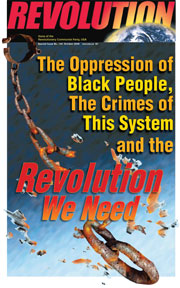The Myth of Mother Teresa:
Pope Francis Puts an Enemy of Women and the Poor on the Road to Sainthood
January 12, 2016 | Revolution Newspaper | revcom.us
On December 18, the Vatican announced that Pope Francis had “verified” a second “miracle” attributed to Mother Teresa since her death in 1997, paving the way for her to become canonized—declared a “saint.” (According to Catholic mythology, it takes two miracles to prove that the person being prayed to is in heaven: the first makes them “blessed”; a second “miracle” means they can become a “saint.” The myth is that only those in heaven can “intercede with God” on the person’s behalf.) Mother Teresa’s first supposed miracle—the claim that a beam of light from her picture made an Indian woman’s cancerous tumor go away in 2003—is contradicted by the explanation of the woman’s doctors, who said that she didn’t have cancer and the tumor responded to medical treatment. This time, we’re told a man in Brazil with a serious viral brain infection was cured by supernatural healing in 2008 after his wife prayed to the Blessed Mother Teresa.
The pope’s official designation of Mother Teresa’s official “sainthood” isn’t expected to come until September 2016. But for the Catholic hierarchy, from the Vatican on down, Mother Teresa has been a “saint” for decades.
As we have written earlier, Pope Francis is being branded the “People’s Pope” for giving up some of the traditional ceremonial trappings of the position; for his expressions of concern over the worst abuses of capitalism; and for his expressions of sympathy for the poor in a world of extreme and savage inequality. He has called the Church “obsessed” with condemning same-sex relationships and forcing women to bear children against their will by opposing not just abortion but any form of birth control—while making clear there cannot and should not be any fundamental change in the Church’s position. And he’s even called for “an integrated approach to combating poverty, restoring dignity to the excluded, and at the same time protecting nature.” (See “The ‘People’s Pope’: This Is NOT a New Catholic Church” at www.revcom.us.)
But Pope Francis has also sent a message that the Church will support you only if you accept the framework—the current world order—and work for modest reform. The essential message of this pope to the poor and oppressed, like every pope before him, is subservience in this world—which means subservience to a world order of genocide and oppression of whole peoples, while waiting for relief in an imaginary “after-life.” It means accepting and working within a world built on exploitation enforced with violence; and submission to the most obscene degradation of women as less than human. And the pope condemns and opposes any attempt to seriously stand up against the suffering produced by a global system of oppression.
The Myth of Mother Teresa
Mother Teresa has been made/turned into a world-famous icon because she embodies that same message. She has been promoted and is seen worldwide as a model of dedication and sacrifice to help relieve the suffering of the poor and destitute of the world. Much of this surrounds her work among the sick and dying of Calcutta, India—now called Kolkata—which earned her the title of “Saint of the Gutters.”
But the incredible hype that has been created around Mother Teresa for decades, so valuable in service of the interests of the Catholic Church and of the imperialist powers and their system, has been called out and exposed from many different angles—by doctors, social workers, academics, and others—who’ve examined the way people are mis-treated at the missions, and much, much more.
The reality of Mother Teresa’s life is that of a religious fundamentalist, a fanatic and bigot, whose concern for the poor was wrapped in a message of acceptance and obedience. Her centers for the sick and dying were not about treatment but about teaching acceptance of their permanent “wretchedness,” while manipulating them in service of the expansion of Christianity among people of other religions. She used her worldwide platform to promote vicious attacks on women around the world fighting against centuries of patriarchy, including the most basic right to control their own bodies through access to abortion and birth control. Mother Teresa used her reputation to bring acceptance to dictators like Jean Claude Duvalier of Haiti; to intervene on behalf of swindlers like the Christian fundamentalist and convicted embezzler Charles Keating; and to praise and promote the war criminal Ronald Reagan at the very time he was having people slaughtered in Central America. In exchange for her endorsement and photo ops with her, millions of dollars were contributed to her charities.
Pope Francis chose his visit to the U.S. last October to canonize a genocidal missionary—Junipero Serra—knowing, and excusing the fact, that Serra and the Church were responsible for the killing of 60,000 Native Americans in his California missions. (See “Genocidal Maniac Declared a Saint: Junípero Serra and the Pople’s Message for Today“ at www.revcom.us.) And now he has decided the value to the Church of elevating Mother Teresa to sainthood is worth the risk of exposure of the Vatican’s actual message and motives.
Enemy, Not Advocate, of the Poor
At the time of her death, Mother Teresa’s Missionaries of Charity had opened 517 hospices and homes for the poor and sick in more than 100 countries. The medical journal Lancet, after a visit by doctors to the Missionaries of Charity facilities in Kolkata, published a report in 1994 of the kind of treatment the destitute, with HIV/AIDS, leprosy, and tuberculosis, were receiving. And two years ago, a paper published in the Canadian journal Studies in Religion/sciences religieuses by professors from two prominent Canadian universities examined nearly all of the written materials ever produced about the life and work of Mother Teresa. If you thought the mission of the Missionaries of Charity was to bring care and treatment to those in most desperate need, you’re not even close. What these journals found was grotesque—and intentionally so.
The doctors were shocked by the supposed treatment of those who had come for help in these “homes for the dying.” While there were doctors who called in from time to time, usually the sisters and volunteers made decisions about treatment for the two-thirds of the people coming there hoping to find a doctor. They found a lack of hygiene and unfit conditions, a shortage of actual care, and inadequate food. And even those who were dying in incredible pain were denied painkillers; instead they were simply left without receiving even the most basic care.
This was not due to a lack of funds—the foundation created by Mother Teresa raised hundreds of millions of dollars. These conditions were in fact deliberate—an approach to caring for the sick that glorified their suffering instead of relieving it. As Mother Teresa herself put it (in response to a question at a 1981 press conference, “Do you teach the poor to endure their lot?”): “I think it is very beautiful for the poor to accept their lot, to share it with the passion of Christ. I think the world is being much helped by the suffering of the poor people.”
A volunteer in Kolkata described what she found inside these missions this way: “My initial impression was of all the photographs and footage I’ve ever seen of Belsen [Bergen-Belsen, a Nazi concentration camp] and places like that, because all the patients had shaved heads. No chairs anywhere, there were just these stretcher beds... there’s no garden, no yard even. No nothing.” There were just two rooms with over 50 men in one and over 50 women in the other—dying.

On her first day, this volunteer saw a 15-year-old boy who was dying. A doctor told her he’d been trying to treat the boy, who had a relatively simple kidney complaint that got worse and worse for lack of antibiotics. The boy needed an operation, and the doctor was angry. He said: “Well, they won’t take him to the hospital.” She asked the doctor why they didn’t just get him a cab to the hospital and demand he be treated. The doctor said, “They don’t do it. They won’t do it. If they do it for one, they do it for everybody.”
Conversion, Not Treatment
All of this is consistent with the actual mission of Mother Teresa and her centers—to convert the people under their “care” to Christianity. In February of this year, prominent Hindu nationalist politicians in India criticized the actual motives behind the centers as principally bringing people into the Catholic Church from other religions. This went so far as to keep the baptisms of Hindus and Muslims secret—even from those being baptized! On the verge of death, people were asked not whether they wanted to convert to Catholicism, but if they wanted a “ticket to heaven.” If so, the nuns would pretend to cool the patient’s forehead with a wet cloth, while in fact baptizing them. Apparently, she was video-recorded saying:
Something very beautiful: not one has died without receiving the special ticket for St. Peter as we call it. We call baptism “Ticket for St. Peter.” We ask the [dying] person do you want a blessing by which your sins will be forgiven and you receive God. They have never refused. So 29,000 have died in that one house from the time we began in 1952.
The centers run by the Missionaries of Charity in Papua, New Guinea, don’t have any patients in them; they’re solely used to convert the local people to Christianity.
Nobel Peace Prize for Promoting the War on Women
Mother Teresa was awarded the Nobel Peace Prize in 1979. By then she had already been elevated to a global icon for the work of her Missionaries of Charity in India. Upon receiving the award, you might have expected her to make a worldwide appeal to put an end to the horrific conditions faced by vast portions of humanity around the world, and to point to the role of wealthy and powerful nations and governments in perpetuating this suffering. But in her speech accepting the award, she never mentioned the war on the poor by this system, to say nothing of resistance—instead, she poured out the most vicious attack on women all over the world. After first blaming mothers forced to go to work for the rising use of drugs among young people in the West, she went on: “I think that today peace is threatened by abortion, too, which is a true war, the direct killing of a child by its own mother.... Today, abortion is the worst evil, and the greatest enemy of peace.” (The Missionary Position, Christopher Hitchens, p. 57)
This so-called “helper of the poor” has “helped” the Church’s efforts in forcing millions of women to risk back-alley or self-induced abortions that lead to the death of tens of thousands of women every year from botched abortions. The Church—and its icons—are soaked in the blood of women, from head to toe; while countless more millions of women are forced to bear children against their will, due to the Church’s opposition to birth control.
Servicing the Interests of Imperialism
In Mother Teresa’s travels around the world promoting her work and raising money, she took the time to publicly embrace—literally—hated dictators and world leaders who were carrying out crimes against humanity. In 1975, to curry favor with India’s Congress Party, she endorsed Prime Minister Indira Gandhi’s suspension of civil liberties, saying: “People are happier. There are more jobs. There are no strikes.” In addition to her prominent photo ops with the wife of the hated dictator “Baby Doc” Duvalier of Haiti, she visited the arch-conservative Prime Minister of England Margaret Thatcher—and their private meeting didn’t focus on the homeless and the “Cardboard City” that had become a major issue in England, but on opposition to abortion, at a time when a bill was going through Parliament to make it less available to women.
Mother Teresa went to the White House in 1985 after President Reagan gave her the Presidential Medal of Freedom. Reagan was overseeing genocidal wars in El Salvador and Guatemala and arming the Contras against Nicaragua; in 1980 Archbishop Romero and four nuns were murdered by the U.S.-backed regime in El Salvador. Despite all this, Mother Teresa had no trouble telling the world, “I am most unworthy of this generous gift of our President, Mr. Reagan, and his wife and you people of the United States.” And she went on to say, “I never realized that you loved the people so tenderly.”
In the same period, she went to Nicaragua and El Salvador and then to Guatemala, where she said, at a time when the slaughter of the indigenous peoples had become a worldwide issue: “Everything was peaceful in the parts of the country we visited. I do not get involved in that sort of politics.”
——————————
For the Catholic Church, and for the imperialist system, there have been few more valuable myths in the contemporary era that have been spread among the masses of people worldwide than “Mother Teresa.” This actual symbol of fundamentalist ignorance and blind subservience and obedience—who taught the poor not to rebel against, but to accept, endure, and indeed relish, their wretchedness; who contributed to the aggressive reassertion of the patriarchic oppression of women; and who was a willing apologist for those responsible for war crimes and crimes against humanity—is once again being dragged out to deliver the message.
What we need is not yet one more saint to make slavery more tolerable. What we need is leadership in the fight to do away with slavery. We need a revolution. And we need it as soon as possible.
Volunteers Needed... for revcom.us and Revolution
If you like this article, subscribe, donate to and sustain Revolution newspaper.



 The notion of a god, or gods, was created by humanity,
in its infancy, out of ignorance. This has been
perpetuated by ruling classes, for thousands of years
since then, to serve their interests in exploiting and
dominating the majority of people and keeping them
enslaved to ignorance and irrationality.
The notion of a god, or gods, was created by humanity,
in its infancy, out of ignorance. This has been
perpetuated by ruling classes, for thousands of years
since then, to serve their interests in exploiting and
dominating the majority of people and keeping them
enslaved to ignorance and irrationality.






